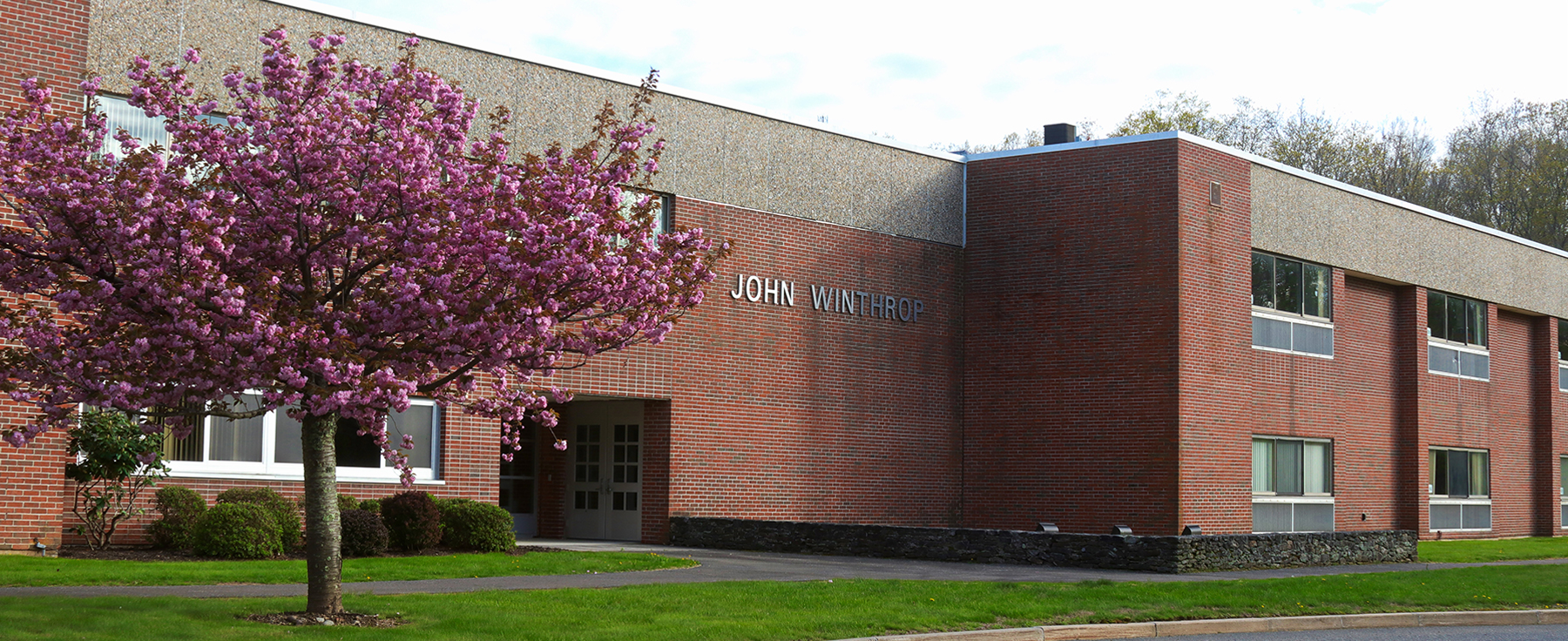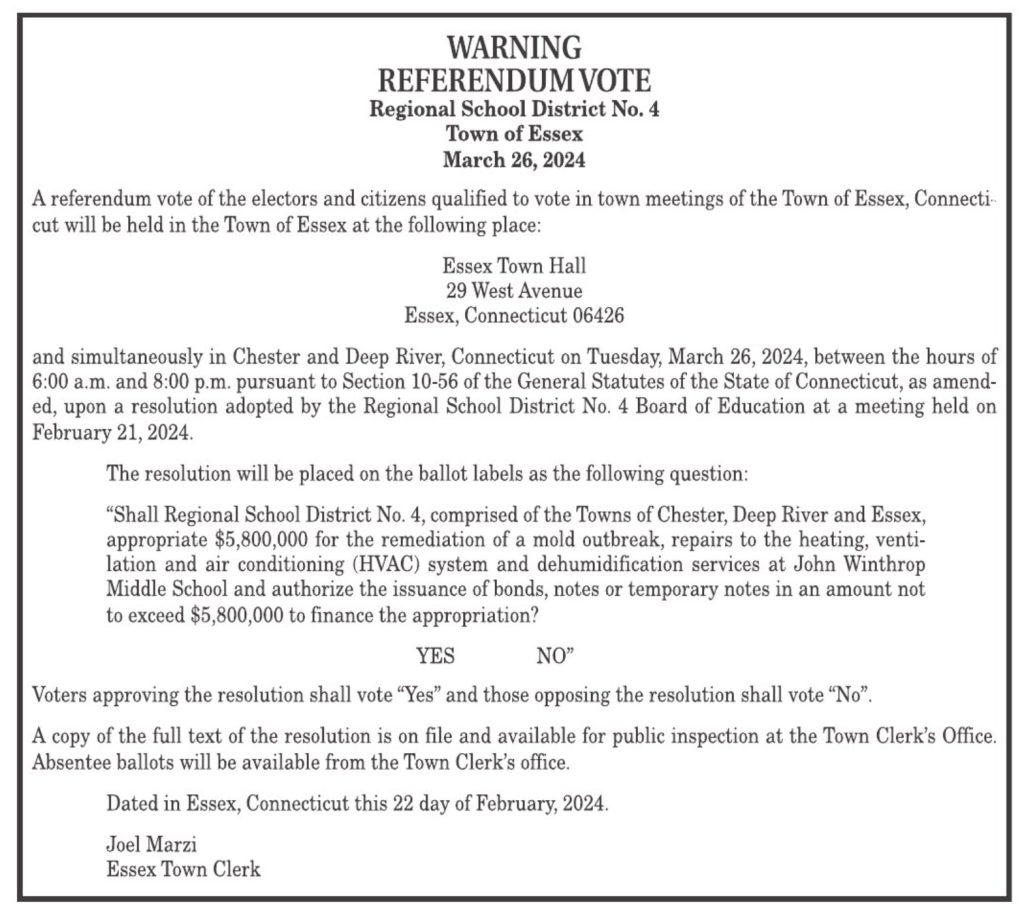UPDATE: The referendum passed. Here are the results:
Yes No Chester 308 172 Deep River 318 263 Essex 502 162 TOTAL 1128 597
First up a disclaimer: I serve as member of the Region 4 Board of Education (I began in 2020) and separately serve as a member and chairman of the Essex Board of Education since 2003. As such I’m relatively new to the unique problems at the regional schools but very familiar with some of the other challenges related to the district as a whole.
The analysis and commentary you are about to read is my own personal opinion and not necessarily that of my colleagues on the Region 4 Board of Education. Although the Board and school administration are prohibited from communicating in the run-up to the referendum I am able to do so as an individual citizen.
Want to get updated as I update this document or the vote in general?
Sign up to receive email updates here.
With that said, let’s dive into what happened and how we can address the problem.
The summary of this issue is as follows: Faulty insulation around air conditioning cold water pipes in the ceiling and failed HVAC controls at the John Winthrop Middle School (JW) led to the exterior of the insulation condensing similar to a cold soda can in the summer. The resulting water absorbed into the ceiling tiles, which in turn promoted the growth of mold throughout the building. The Board’s plan is to clean up the mold, fix the root cause of the failure (the pipe insulation & HVAC controls) and return students to the building by the fall.
We can’t do more than this at the moment because there are not enough students in the building to qualify for state construction reimbursement (more on this below). The reimbursement rate for JW, if we met state enrollment standards, would be 47%. The rate would rise to 57% if we added a grade into the school. To fully renovate the building would cost at least $30 million – money that would need to come almost entirely out of property taxpayers’ pockets without significant state reimbursement. While there is the potential for reimbursement for the repair work we are proposing, anything beyond that would not be eligible.
Due to the complexities of our district governance it’s not possible to make grade configuration choices quickly as our communities need time to figure out the best course of action for the other schools in the three towns. We are confident that repairing the root causes of the current situation will make the building safe and give us the time we need for that discussion.
The details of this problem and how the decision was reached are below. This is a long read but the below table of contents should help you navigate through it. If something is not covered please email me at lonseidman@gmail.com.
What you are about to read is essentially what I spoke about at the public hearing held on February 21st.
The Problem
The Board’s Proposed Solution
Q&A:
Why not fix the roof, windows, the HVAC and everything else?
What if we don’t do anything?
Is John Winthrop Worth Saving?
Has the District Irresponsibly Deferred Maintenance?
Why Not Portables?
What About The $9 Million+ Athletic Field Project?
What’s the overall impact on taxpayers going to be?
The Problem
This fall the students at the John Winthrop Middle School were displaced due to an overabundance of moisture and subsequent mold that grew as a result of the moisture. For a more technical explanation, please click here to read the root cause analysis from our architects. What will follow is my own explanation based on the linked report along with my personal observations of the building and conversations I’ve had with staff and experts.
On September 11, 2023, First Selectman Norm Needleman of Essex asked me to tour the building with him as he wanted to see the situation for himself. This tour took place only a few days after students were moved out of the building.
We entered the building with moisture detectors that display humidity levels, temperature and dew point. I have learned that general guidance for preventing mold growth is to keep relative humidity levels below 60%. On the day we visited most of the building had levels exceeding 70%, including this reading of 71.7% we received in a classroom:

The Culprit: Air Conditioning Water Pipes
With moisture levels this high, the dew point was practically at room temperature. This means that it doesn’t take much to condense that moisture in the air into water. In this case, air conditioning pipes that run throughout the entire building provided a cold enough surface for that moisture in the air to condense into water.
Heating and cooling in a building like John Winthrop is not a monolithic air conditioner but rather a system of individual heating and cooling units. Each component is unique but it all works together to regulate the internal environment.
One part of JW’s air conditioning system is a system of looping pipes of chilled water that run through the ceilings in a closed loop system. That water is chilled by units outside and is used by the many unit ventilators throughout the building in the warmer months to keep rooms cool and comfortable. The water warms up as it passes through, and the chillers cool it back down as the water completes one loop and starts a new one.
In the fall as temperatures get cooler, the chillers are shut down and those same water pipes are used to run hot water from the boilers for the heating system.
Twenty years of this hot/cold cycle took its toll on the insulation causing it to fail. That failure resulted in the outside of the insulated pipes getting cold enough for moisture to condense into water. That water then dripped onto the ceiling tiles where it was absorbed. This essentially turned the building into a giant humidifier.
The moisture in the air and the water dripping off the pipes created a perfect environment for mold growth. Most of the visible mold appeared on the insulation as can be seen in the photos below. Additionally mold spores were detected on other surfaces below the ceilings.
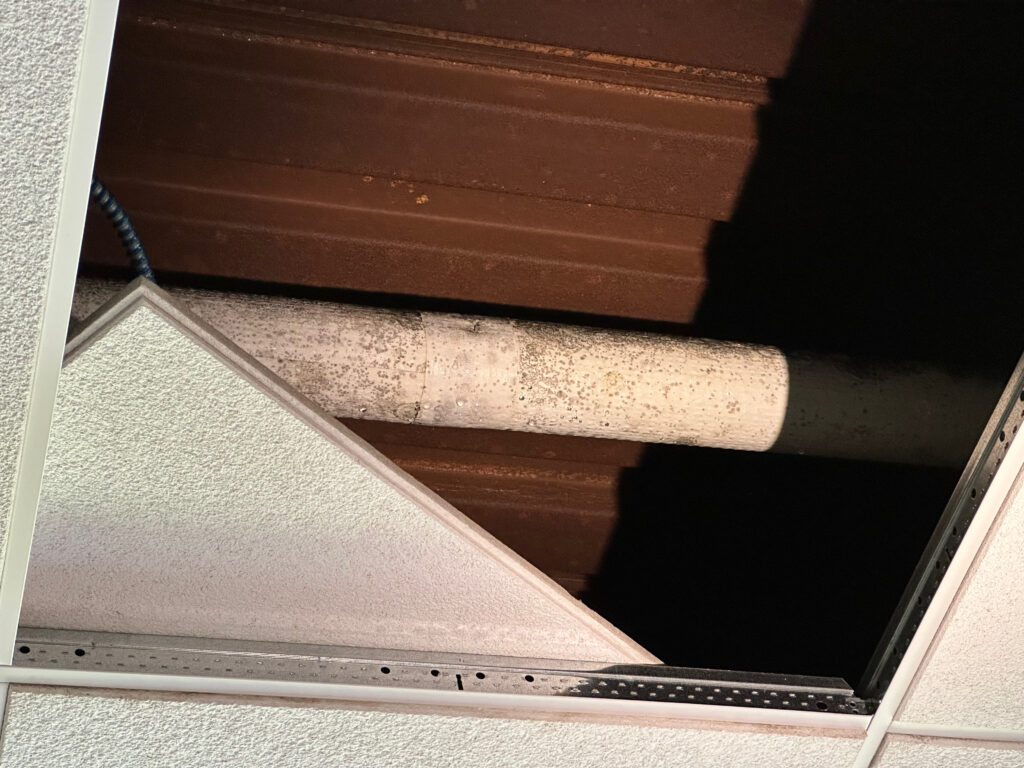

The Accomplices: A Failed HVAC Control System & Deteriorating “Building Envelope”
How did all of this moisture get into the building in the first place? A couple of factors are to blame. The most significant one for this particular situation was the failure of the HVAC control system to regulate the amount of fresh to recirculated air flowing through the building. This system was due to be upgraded and repaired this year and vendors were quoting on the work around the time this event occurred.
It is suspected that window ventilator units were letting in too much fresh air as their vents to the outside were unable to be controlled automatically. On top of that, motion sensors in the unoccupied rooms kept the air conditioning off which would have helped to bring the moisture level down.
Additionally JW is aging and has many infiltration points for moisture throughout the exterior including the windows, mortar, and portions of the roof. More on that later.
The Board’s Proposed Solution
My second visit to JW was on October 12th, about a month after my first visit. To my surprise the moisture levels in the building reduced dramatically – most of the rooms were at or below 50% relative humidity.
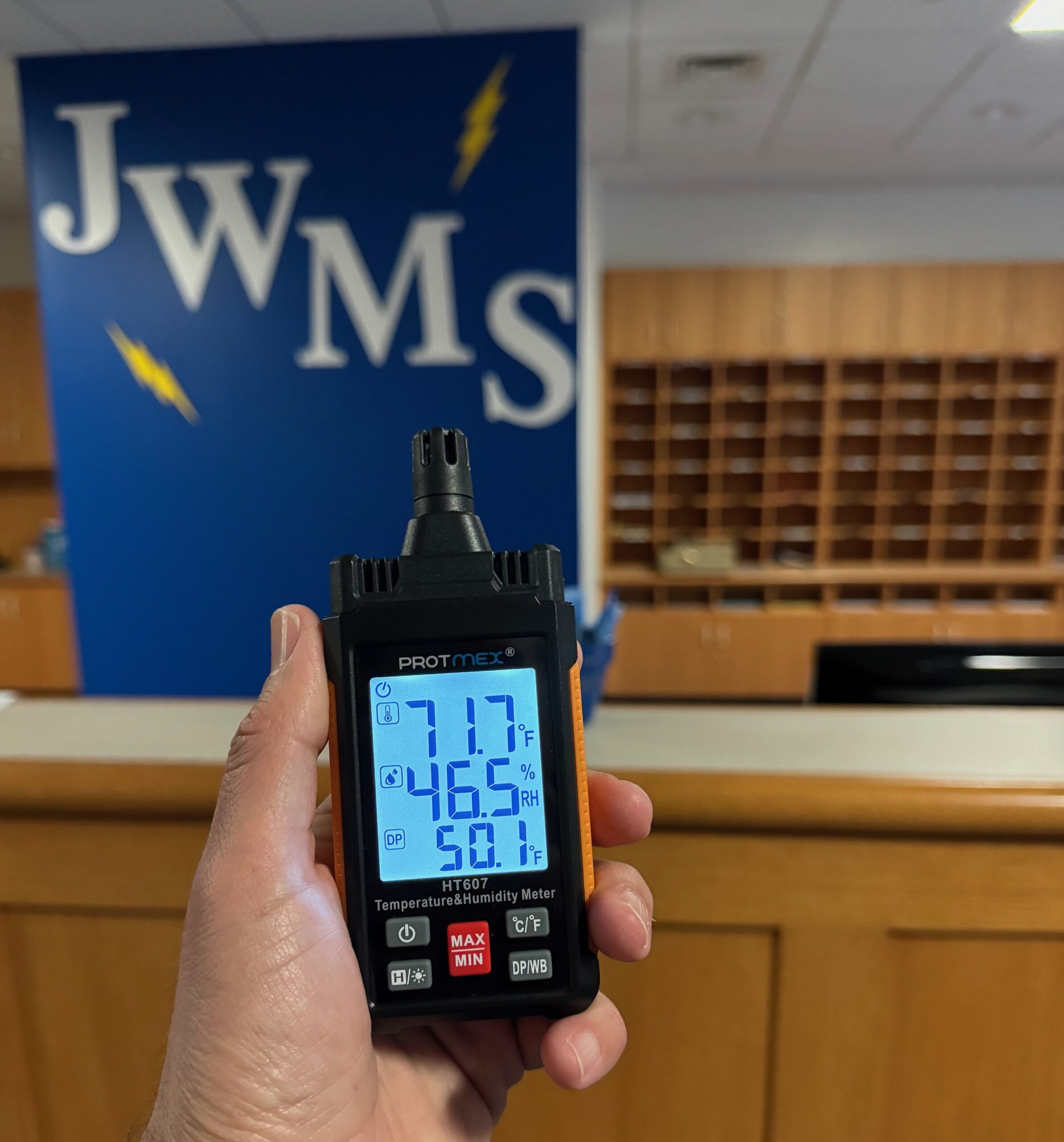
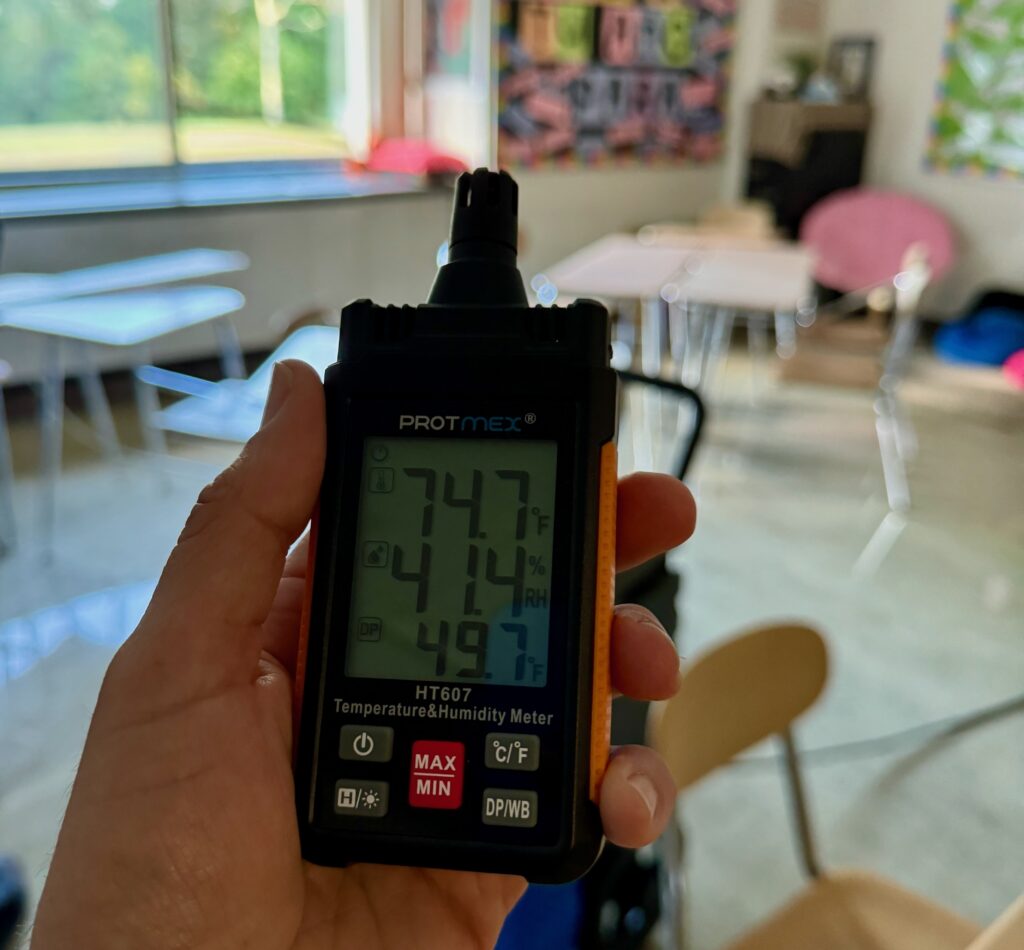
So what changed? First the building staff manually managed the HVAC controls and limited the amount of fresh air coming into the building. They also switched the HVAC system over to its heating configuration so that those cold water pipes began carrying hot water instead. The outside air became less humid too as the cooler autumn air was beginning to kick in.
What’s most important to note is that the building dried out on its own. Since October, the moisture level has fallen further with relative humidity in some rooms in the mid 30 percentile range. Even after the torrential rain storms that flooded homes and businesses throughout the region in January, JW remained dry. Mold cannot grow under these conditions – so the mold present is now dormant – at least until the weather starts warming up again.
This data shows us that the moisture problem was limited to the late spring and summer months, and that it’s possible to manage the moisture to prevent future outbreaks of condensation and mold during that time period.
With this data in mind, the solution the board settled on has three pillars, focused on addressing the culprit (the insulation) and the accomplices (the HVAC control system and portions of the building “envelope”):
1. Remediate the Mold
The district owes a duty of care to students and staff to ensure mold is properly removed from the building. This includes cleaning all of the air handlers, furniture, etc. and removing the moldy failed insulation.
2. Repair the Insulation
The insulation needs to be replaced after it is removed. Modern insulation is better than the type used twenty years ago and is made with new materials that prevent the growth of mold. This repair, if made properly, will prevent condensation and future mold growth addressing the root cause of the problem.
3. Replace the Building HVAC Control System & Patch Areas of Water Infiltration
While the current HVAC systems are nearing their end of life, they are still able to be controlled by a more up-to-date control system that can manage the mix of fresh to recycled air in the building. This will keep most of the moist, untreated air out of the building. Also in the budget are dehumidifiers to help manage the moisture levels.
Contrary to what some say, this is not throwing money away on a short-term fix. It’s an interim step and right now the only thing we can realistically afford to do (see the next section as to why). The board’s plan will give building staff the ability to manage the problem and get students back into their home school safely this fall. Two thirds of the repair project will essentially be a down payment on future HVAC work as the improvements will carry forward to additional HVAC upgrades later on.
Q&A: Why not fix the roof, windows, HVAC and everything else?
So why not do more if we know the HVAC needs to be replaced along with the windows and the roof? Here’s why:

Our architects estimated the cost to replace the HVAC system, roof and windows along with other repairs to fully address the building envelope will likely cost $37.5 million. This figure did not assume any code compliance issues that may come up with a full building renovation.
Of that amount Chester, Deep River and Essex taxpayers would be on the hook for most of that cost. Why? Because of Connecticut’s space standards for school construction. The state of Connecticut provides generous grants to towns for school renovations but only if the square footage of the project falls within guidelines. Because JW is so large, and our enrollment now is so low, most of the project would not be eligible for reimbursement.
Normally a right-sized building would get 47.6% for general construction and 37.86% for new construction (the state currently incentivizes renovating existing spaces vs. building new). If the towns voted to add a grade to Region 4, those numbers would increase by an additional 10%.
In other words we’d be leaving over $21 million in state reimbursement on the table by renovating everything right now. This would put almost the full burden of repairs on property taxpayers. Additionally students and staff would be displaced and crammed into Valley Regional High School for at least another year if not longer.
JW, Valley Regional High School and our elementary schools are all below the current state space standards for reimbursement. Our communities will be facing sizable building physical plant costs in the future if we don’t do something to smartly address our enrollment decline now while we still have time.
Is John Winthrop Worth Saving?
Absolutely. Although we do currently have the moisture issue to contend with, the building is in decent shape for its age and the time elapsed since the last major renovation. You can read more about the building’s condition in the report the Board of Education commissioned last year.
Most important is what the community will lose if we shutter the building before carefully thinking about district configuration. JW is one of the rare middle schools in the state that has a full size gymnasium, auditorium and very large program spaces for all of the specials we offer. These spaces are also heavily utilized by community groups too. State space requirements for new buildings no longer allow these things, so if a new building was constructed in its place we’d lose them.
Additionally because this building is so large it has a lot of potential to be divided and/or repurposed for whatever solution the communities come up with for future grade configurations.
There is a misconception that closing the building will save money. The reality is it likely won’t. Approximately 80% of the Region 4 budget is spent on staff and mandated special education services. There is not much overlap in staff between the middle school and high school so any consolidation savings will be minimal.
Even if the JW building is empty the district would need to pay for an addition to Valley Regional High School along with the cost of either keeping JW from becoming a safety hazard or tearing it down. We may as well make use of this asset and keep it available as a potential solution to our larger district issues.
Lastly, JW is the designated shelter location for emergency management. Our local emergency planners have moved some of the emergency supplies to Valley Regional High School but JW is still the preferred location. JW has a larger freezer space for food and medicine storage along with an on-site building-wide generator.
Q&A: What If We Don’t Do Anything?
If we don’t do anything the building gets worse. We’ll have another season with failed insulation and failed HVAC controls that will likely bring with it more condensation and more mold growth. Mothballing the building and keeping it from deteriorating further will still cost the district money and the students & teachers will still be displaced. The best solution is to keep it operating and occupied.
With these proposed repairs building staff can manage moisture in JW and give the community time to figure out what we need to do in order to effectively address upcoming facilities costs throughout the school system.
I feel it’s important we protect this asset which may prove to be an important part of whatever solution we eventually come to on school and grade configuration.
Q&A: Has the District Irresponsibly Deferred Maintenance?
The short answer is no – the district has properly executed its day-to-day maintenance and repairs within its budget. But like everything in this district it’s more complicated than just a short answer.
Maintenance of facilities of this size involves day-to-day and spot repairs, but it also includes more sizable expenditures like replacing components that reach the end of their service life and renovating buildings when small repairs are not enough.
The larger issue, in my opinion, is that a bulk of the longer term work in Region 4 happens in 20-30 year cycles. These repairs and renovations often consist of very large bond issues that try to tackle as many long term problems as possible, but leave many other items to wait until the next go-around. The result is that many large systems all get repaired at once, which means they all tend to wear out around the same time two decades later.
Some good examples of this practice include the Region 4 athletic fields that were in need of a major renovation for quite some time along with the windows in JW that have long been in need of replacement.
I believe spreading this work out over time will greatly benefit taxpayers by stabilizing the debt service line in the budget. Rather than one huge bond project every 20-30 years, having smaller individual projects staggered over this same time period will allow more projects to be done when they need to be while keeping the school budget (and taxes) stable.
When a staggered approach is executed effectively, the debt service line in the budget stays relatively flat year over year but the district is able to keep up with big ticket maintenance items individually. This is a strategy Essex has employed for many years for both its municipal and elementary school physical plant needs. It reduces the risk of surprises like the JW situation.
Implementing this strategy needs to be part of the long term planning the school boards need to begin soon.
Q&A: Why Not Portables?
The Board did investigate portables as we were looking at various options. Portables would likely cost almost as much as the proposed plan when all is said and done. They are not as simple as rolling a trailer off a truck. There would need to be significant site work, utility installation, plumbing for bathrooms, etc.
Educationally portables would impact the teaching and learning experience especially when it comes to tech ed (formerly known as industrial arts), music, and many of the other programs that require a more specialized classroom.
I’m also concerned that portables may not meet the state’s new more stringent indoor air quality standards for schools. The synthetic materials used outgas volatile organic compounds (VOCs) that need to be under a certain threshold to meet the state’s new mandate. Additionally portable classrooms are known for being susceptible to water intrusion and yes, mold growth.
And after spending several million dollars to put these portables in place, we’d eventually remove them. It doesn’t make sense to do this when we already have a perfectly functional middle school that can meet the educational needs of students once repairs are made. And 2/3rds of the work done on this project will remain with the building in the future.
Q&A: What About the $9 Million Athletic Fields Project?
Last year voters authorized a $9,966,000 expenditure to renovate the athletic fields at JW and the Valley Regional High School. While these funds were authorized, they have not yet been spent or borrowed. While portions of the project should continue in my opinion, I believe the board should be more cautious about how much of the project is undertaken until we know the final cost of the repair work and what the impact on our debt service line will be. The work planned in the near future on the fields will be a portion of the project and is not the full amount that was authorized.
Q&A: What’s the overall impact on taxpayers going to be?
State law requires voters to authorize the full dollar amount of a project, even if the state will be reimbursing portions of the cost. For this project, Region 4 is pursuing a state grant to supplement the cost of the work.
As noted above, Region 4 is allocated a 47% reimbursement rate from the State of Connecticut for approved projects. This scope of the repair work falls under an emergency provision of state law that does not penalize us for the number of students in the building. Due to the timing of the project we unfortunately won’t have confirmation about how much reimbursement the district is eligible for until after the referendum.
Even if we receive no reimbursement, the budget impact will be minimal. Region 4 has carried approximately $1.5 million annually in its budget for debt service for the last 20 years or so. Debt service payments are similar to mortgage payments and are amortized in a similar way over a period of usually 20 years. The debt service line is used to pay down the bonds that were used to borrow money for the previous renovation projects.
Region 4’s current debt will be fully paid off this year, meaning the district will be entering the next fiscal year debt-free. So with the repair work, some athletic field renovation and the previously authorized security project, the debt service will be well under the amount the district has been carrying for the last twenty years.
Yes, more significant work needs to be done in the future but with that could be some savings from potential grade reconfiguration and the subsequent state reimbursement. The repair work is also giving us a head start on some of the HVAC improvements.
The bottom line is we need start planning the long term work now. This includes grade configuration, facilities planning and staggering our debt. We have a very narrow window to get this right. If we do nothing there will be a significant tax impact in all three towns that we can avoid – but only if we stop kicking the can down the road on making our school system more efficient.
Paid for by Lon Seidman
